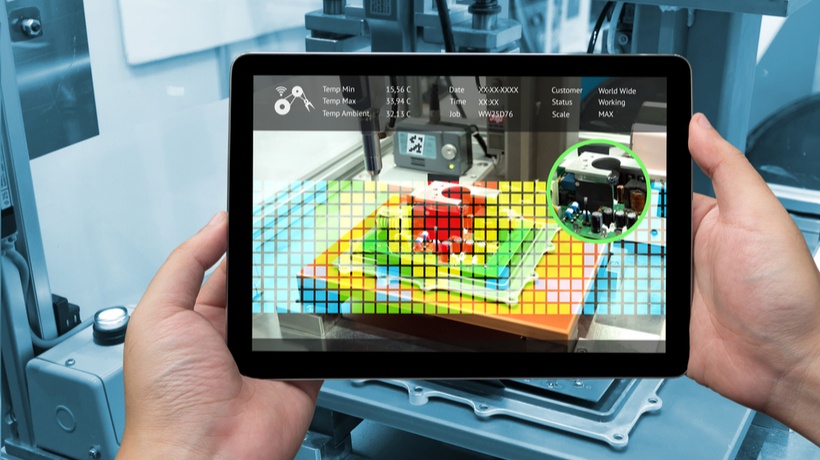Why You Should Adopt Augmented Reality In Corporate Training
The Augmented Reality (#AR) market is estimated to be US$120 billion by 2020. Learners always wanted the highest level of personalization while learning, but organizations always wanted a cost-effective solution that gives highest returns and results from a training program. AR technology is an answer to help:
Learners:
- Learn anytime!
- Learn anywhere!
- Learn on demand!
- Get accurate content!
- Engage in learning!
- Get personalized content!
Organizations:
- Content at less cost!
- Connect with learners!
- Bring in more accountability!
- Increase efficiency!
- Measure outcome of learning more effectively!
- Push specific content to a learner!
Keeping the need for personalization, simplification, accurate content, and measurable content, over the last few months we have been conducting sessions with our partners across BFSI, Hospitality & Tourism, and Healthcare industries on Augmented Reality (AR) and its application in corporate eLearning. We have received some great insights ranging from content engagement to costs, to data security.
New technology, as we all know, takes time to be adopted. We are all waiting for the next person to use it before we realize we should have done it a long time ago. In today’s economic climate, do organizations have time to wait and watch as their competitors adopt new technologies and enjoy the ROI?
This article is a collection of thoughts after discussing with industry leaders on the application of Augmented Reality in eLearning. Part 1 of this article will provide an insight of questions asked and their answers/discussions, and Part 2 will highlight answers that are critical to the adoption of AR in corporate training.
The objective is to help you make a well-informed decision on #AR and whether it is worth testing in your current eLearning environment.
Part 1: 5 Questions For Industry Leaders
When I first started on this project, my engagement on AR (as I’m sure with many of you have gone through) was Pokémon GO.
One of the biggest outcomes of the Pokemon craze was how it got people motivated and inspired to get hooked and stay that way, even when the searching process got more difficult. This leads us to the first question that we asked our customers:
1. Do Your Employees Enjoy eLearning?
Apart from compulsory eLearning where employees have to complete eLearning modules as a part of their job responsibility, employees today aren’t really interested in going through lengthy modules which still run on outdated technologies. Many of our partners highlighted that while “gamification” has brought a change in eLearning attitudes, it is not possible to “gamify” every eLearning topic purely because it is expensive. Many topics aren’t game-friendly topics as well.
2. What Is That One Area You Would Like To Improve, In Your Employees, Through eLearning?
Before I present the summary of our discussion, I want to state we are not discussing core functions of employees…we are discussing the behavioral and/or decision-making side of their jobs. While asking this question, we noticed a commonality in many of our customers' responses. Many customers mentioned that apart from improving their core function, they would really like to understand and improve their employees’ behaviors towards tackling problems related to their jobs... i.e. better decision-making.
While today’s eLearning has become highly evolved through the assessment with and without gamification, the eLearning managers are still not sure whether the employees are able to improve the decision-making skills that would help them in tackling critical problems on the job.
3. Have You Heard Of Augmented Reality In eLearning?
The most common answer we heard was, “I’ve heard of AR but I’m stilling looking for applications of AR in eLearning”. It was clear that gamification was still on everyone’s mind (although everyone agrees that it is expensive).
4. Would You Consider AR In Your Future eLearning Courses?
It was interesting to note how Learning and Development managers are relating AR as a new technology to a younger workforce. Some L&D managers mentioned of the “Snapchat glasses” and said they would be keen to see how they applied in corporate eLearning.
It is true that Millennials are attracted to newer technology and adapt to it much faster than others. As Millennials enter and mature in the workforce, L&D managers are already looking at this age demographic and considering reevaluating their eLearning strategy.
5. Would You Adopt AR If It Were A Cost-Effective Alternative To Gamification And/Or Other Expensive eLearning Strategies?
Almost everyone answered – “Absolutely”.
It was clear, with shortening budgets, L&D managers are looking at innovative ways to increase content engagement and outcomes of eLearning. While gamification is still important, it is very expensive and not every organization (particularly small and medium) can look at gamification as their eLearning strategy.
Part 2: Why Augmented Reality Is A Good Investment
Part 2 of this article will highlight applications of AR, how and where it can be used. Part 2 will address the above concerns and shed light on areas that L&D managers might want to investigate while adopting Augmented Reality. Part 2 will provide insights on how AR is a good investment.
Augmented Reality – Definition
Augmented Reality combines the real world with virtual objects, supplementing the reality instead of substituting it, making the bridge between real and virtual worlds in a perfect.
Augmented reality helps in providing a mix life experience. The learner can relate to the course content better as part of the course involves real-life applications. (Chang, Morreale, & Medicherla, 2010).
1. AR Vs. Gamification
I’m not trying to say gamification isn’t effective or relevant. Gamification without a doubt improves the experience of the user; however, it is expensive.
Many organizations would like the gamified content but are not able to do so because of costs. Augmented Reality is about 40-50% cheaper than gamification! And brings in a mixed life (virtual and real life) experience in contrast to gamification's virtual experience.
While you might not receive an immersive experience through AR (like you would do in VR), you can certainly receive a mix-life experience that would help in improving learning outcomes for your employees.
Augmented Reality is a clear winner in applications that cannot be gamified (or may be too expensive to gamify). BFSI and Healthcare were sectors where AR could be a great value-add. Engineering and Manufacturing are other sectors where AR beats gamification hands down.
We all know from Pokémon GO that integrating AR and gamification creates a very powerful tool!
2. AR May Lead To Better eLearning Outcomes W.R.T Decision Making
In general, AR has shown to be an effective tool to develop skills when compared with other methods, with a greater impact on unexperienced learners and its transfer to real-world scenarios. AR in Healthcare eLearning is seen as a safe simulation method to practice unlimitedly clinical procedures. AR in BFSI has helped in creating a more engaging experience. L&D managers have slowly come to the realization that you don’t have to gamify everything; there are other technologies that can help produce similar if not greater outcomes.
It is not rocket science, a real-world (or blended) application (as compared to gamified) brings in a level of practical experience as compared to virtual gamification. Any application providing practical experience will allow the learner to relate to the learning thereby enhancing their power of retention.
3. Augmented Reality, Existing IT Infrastructure, And Data Security
Because AR requires an app to deploy, it is important to mention and clarify doubts around how it fits in within organizations existing IT infrastructure.
The AR app you develop should not store any data! The data that is distributed through your AR app is hosted on the cloud server and preferably a cloud server that is managed by your organization.
For Subject Matter Experts who outsource the hosting of the app, there should be two levels security (if not more) to ensure that the app is secure and that your data is secure.
The AR developer you employ should be able to connect the AR app to your existing Learning Management System through APIs. This will help in pushing the data across to your LMS providing information to L&D managers on learners outcomes and mapping the course to learners KPIs.
AR apps raised another question, why AR APPS? Why can’t AR be deployed on browsers?
This is probably the biggest challenge when it comes to adopting new technology. While most current, up-to-date technologies run on web browsers (Edge, Chrome, Firefox…), AR apps still run on AR browsers which are embedded within the AR apps.
Augmented reality browsers reported by (Grubert et al., 2011; Jonghong, 2014; and Langlotz et al., 2014) are specialized Augmented Reality applications for rendering geo-located multi-media contents augmented on point of interest of the real world.
While web browsers are aggressively working becoming AR-friendly, for now, any AR application will have to be deployed through an AR browser which will be embedded in an AR app.
Conclusion – Does AR Provide The ROI And Value-Add?
When it comes to corporate eLearning, the industry is clearly facing tightness of budgets. AR as a low-cost solution that enhances the learning experience is a clear answer to this problem. In addition to this, AR through a mixed life (virtual and real-life experience) helps in improving behavioral outcomes. By experiencing real-life problems over a virtual environment, learners increase their retention powers which leads to better learning outcomes.
In addition to behavioral outcomes, AR provides enhances the mobile learning experience. Learners now can not only learn on their mobile devices, they can practice on the go as well. This provides additional motivation to the learner. More practice along with a mix reality experience where the learner can relate to real-world objects will increase his retention thereby improving his ability to do his job.
Lastly, AR brings in eLearning that is ongoing. A few examples:
- Sales training
A Sales manager in a bank can access brochures on bank products, but through AR he could also access eLearning videos, FAQs, and other media assets that would constantly help him in providing better solutions to his customers. - Engineers in manufacturing
We all know that going through manuals is a tedious task, by pointing the mobile device (with the AR app) to the machinery, the engineers can understand through a mixed life experience exactly how to operate the equipment, how to fix it, and how to improve it. This saves a lot of time.
As employee roles become more complex and multi-skilled, AR allows employees to not only improve their core functional skills but also improve their decision-making skills with an added advantage of saving time. As AR evolves, companies like Excelsoft will be providing integrated solutions that will include integrating Augmented Reality with the likes of adaptive learning and gamification.
This will only strengthen the case of Augmented Reality being the preferred low-cost technology that enhances user experiences in eLearning.
To support this further, as low-level hardware will allow us to visualize virtual content anywhere in the real world, Augmented Reality (AR) will become a low-cost gateway to enhancing the existing eLearning experience.








